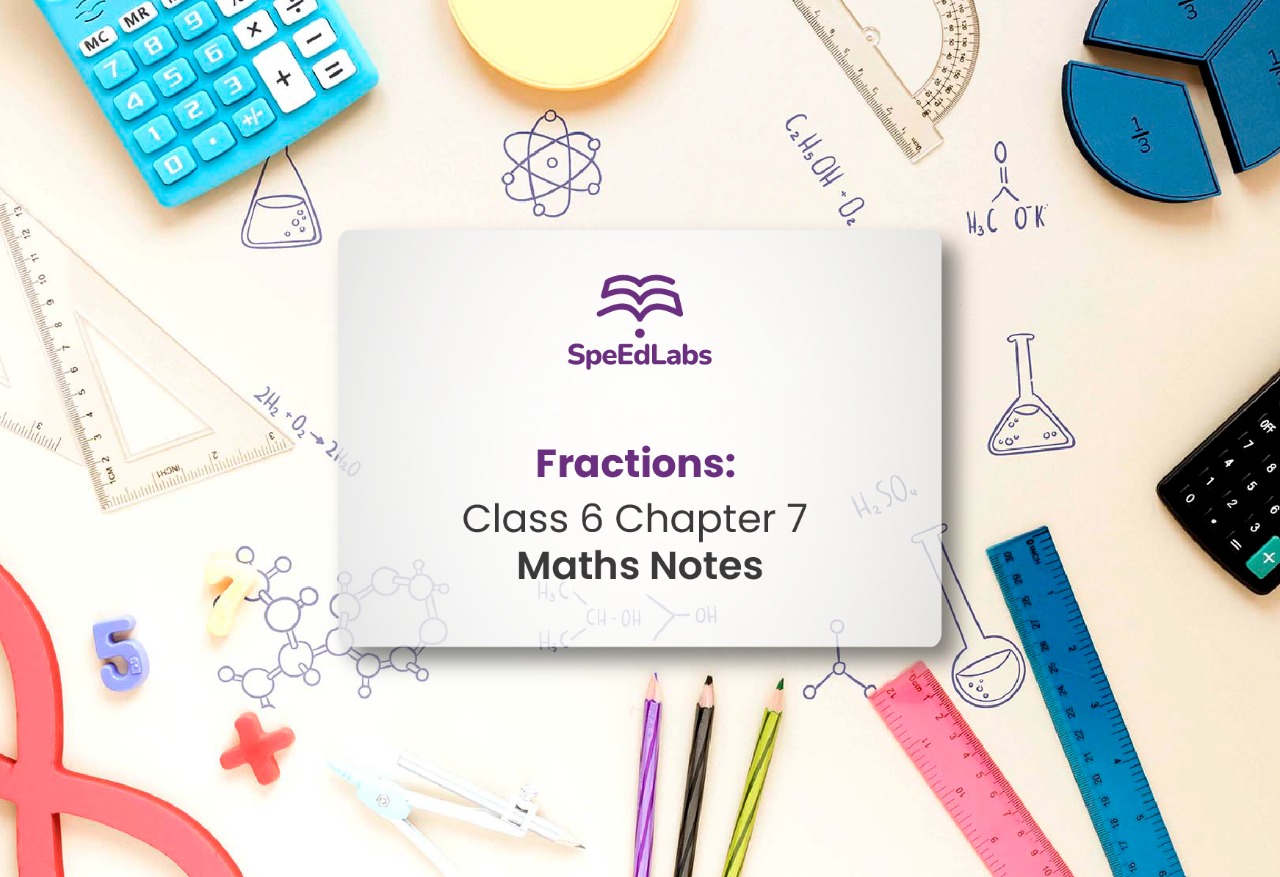CBSE Class 6 Maths Chapter 7 Notes: Fractions Revision Notes & Short Key-notes prepared by expert Maths teachers from the latest CBSE (NCERT) textbooks. The Class 6 NCERT Maths Notes Chapter 7 Fractions seem to help them revise the important concepts faster. Sign up for Maths coaching classes on SpeEdLabs to clear your doubts.
On the official website of SpeEdLabs, you can also register online for NCERT Class 6 Science coaching to score more marks in the CBSE board examination. Students can access free CBSE Solutions (NCERT) and other study materials on SpeEdLabs. To help you revise the entire syllabus and score more marks in your exams, you can download the Class 6 Maths NCERT Solutions.
Fractions Class 6 Chapter 7 Maths Notes
A fraction is defined as a part of a whole number. It can be expressed as a ratio between two integers separated by a solidus. The number in the upper part of a fraction is termed as numerator whereas the number in the lower part is termed as the denominator. For example, let us consider a fraction:
4/12
where,
- 4 is the numerator
- 12 is the denominator
- It is read as four-twelfths
Types of Fractions
Let us understand the different types of fractions. There are five types of fractions. They are proper fractions, improper fractions, mixed fractions, like fractions and unlike fractions.
Proper fractions – It is a type of fraction where the denominator is always greater than the numerator.
Improper fractions – It is a type of fraction where the denominator is always less than the numerator.
Mixed fractions – It is a type of fraction which consists of a whole number and a proper fraction.
Like fractions – The type of fractions which have same denominators are called, like fractions.
Unlike fractions – The type of fractions which have different denominators are called, unlike fractions.
Introduction to Fractions
- A fraction is a number that represents a part of a whole.
- The whole may be a single object or a group of objects.
- Fraction=Numerator/Denominator
- Example: 1/2, 3/7
Representing fractions
Fractions can be represented using numbers, figures or words.
Avatars of Fractions
Proper fractions
- If numerator < denominator in a fraction, then it is a proper fraction.
- Example: 2/3 and 4/9
Improper and Mixed fraction
- If numerator > denominator in a fraction, then it is an improper fraction.
- Example: 4/3 and 8/11
- An improper fraction can be written as a combination of a whole and a part, and is called mixed fractions.
Meet the Twin Fractions
Equivalent fractions
- Each proper or improper fraction has many equivalent fractions.
- Multiply both numerator and denominator by a number, to find an equivalent fraction for the fraction.
Example: 1/2 and 2/4 are equivalent fractions.
Let’s Add Fractions
Addition of fractions
1/3 + 7/3 = (1+7)/3 = 8/3
1/3 + 2/4 = (4+6)/12 = 10/12 = 5/6
LCM
- Least common multiple of two numbers (LCM) is the smallest number that gets divided by both the numbers.
- Example: LCM of 3 and 4 is 12.
Let’s Subtract Fractions
Subtraction of fractions
Many Many Many Fractions Together
Multiplication of fractions
Let’s Divide Fractions
Reciprocals of fractions
- Turning the fraction upside down gives the Reciprocal of a fraction.
- Fraction × (Reciprocal of the fraction) = 1
Division of fractions
- 1/2 ÷ 1/3
1/2 × Reciprocal of (1/3)
=1/2 × 3 = (1×3)/2
=3/2
- 4/3 ÷ 3/2
=4/3 × Reciprocal of (3/2)
=4/3×2/3=8/9
Where do Fractions Live?
Comparison of fractions
- Comparing like fractions with same denominators
2/3 and 8/3
2 < 8
∴ 2/3 < 8/3
- Comparing unlike fractions with same numerators
1/3 and 1/4
Portion of the whole showing 1/3 > Portion of the whole showing 1/4
∴1/3>1/4
- Comparing unlike fractions with different numerators
5/6 and 13/15
LCM of 6 and 15: 30
(5×5)/ (6×5) = 25/30
(13×2)/ (15×2) =26/30
⇒ 25/30<26/30
∴ 5/6<13/15
Fractions on the number line
- The following figure shows how fractions 14, 24 and 34 are represented on a number line.
- Divide the portion from 0 to 1 on the number line into four parts.
- Then each part represents 1/4th portion of the whole.
Why Choose SpeEdLabs for Class 6 Maths Notes?
By providing experienced and skilled mentors, SpeEdLabs increases the online engagement of students. To help students grasp the concepts of Fractions, revision notes on Fractions are provided. Furthermore, students are provided with subjective and objective tests, regular homework, and assignments in Class 6 Maths that enable them to progress academically. By analysing the results of the tests, parents can determine how their children are progressing.
We offer CBSE Class 6 Maths Revision Notes on Fractions curated by our subject experts for easy comprehension and short-cut techniques.
Discover the joy of learning with SpeEdLabs, where learning is fun and not a hassle.
Also read –
- Knowing our Numbers: Class 6 Chapter 1 Maths Notes
- Whole Numbers: Class 6 Chapter 2 Maths Notes
- Playing with Numbers: Class 6 Chapter 3 Maths Notes
- Understanding Elementary Shapes: Class 6 Chapter 5 Maths Notes
- Understanding Elementary Shapes: Class 6 Chapter 5 Maths Notes
Also published on Medium.
